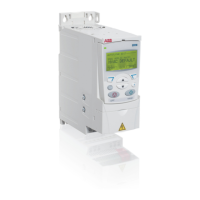Technical data 401
UL marking
See the type designation label for the valid markings of your drive.
The UL mark is attached to the drive to verify that it meets UL requirements.
UL checklist
Input power connection – See section Electric power network specification on page
395.
Disconnecting device (disconnecting means) – See Selecting the supply
disconnecting device (disconnecting means) on page 36.
Ambient conditions – The drives are to be used in a heated indoor controlled
environment. See section Ambient conditions on page 397 for specific limits.
Input cable fuses – For installation in the United States, branch circuit protection
must be provided in accordance with the National Electrical Code (NEC) and any
applicable local codes. To fulfill this requirement, use the UL classified fuses given in
section Size of copper conductor in cablings on page 391.
For installation in Canada, branch circuit protection must be provided in accordance
with Canadian Electrical Code and any applicable provincial codes. To fulfill this
requirement, use the UL classified fuses given in section Size of copper conductor in
cablings on page 391.
Power cable selection – See section Selecting the power cables on page 37.
Power cable connections – For the connection diagram and tightening torques, see
section Connecting the power cables on page 48.
Overload protection – The drive provides overload protection in accordance with
the National Electrical Code (US).
C-Tick marking
See the type designation label for the valid markings of your drive.
C-Tick marking is required in Australia and New Zealand. A C-Tick mark is attached
to the drive to verify compliance with the relevant standard (IEC 61800-3:2004 –
Adjustable speed electrical power drive systems – Part 3: EMC product standard
including specific test methods), mandated by the Trans-Tasman Electromagnetic
Compatibility Scheme.
The Trans-Tasman Electromagnetic Compatibility Scheme (EMCS) was introduced
by the Australian Communication Authority (ACA) and the Radio Spectrum
Management Group (RSM) of the New Zealand Ministry of Economic Development
(NZMED) in November 2001. The aim of the scheme is to protect the radio frequency
spectrum by introducing technical limits for emission from electrical/electronic
products.

